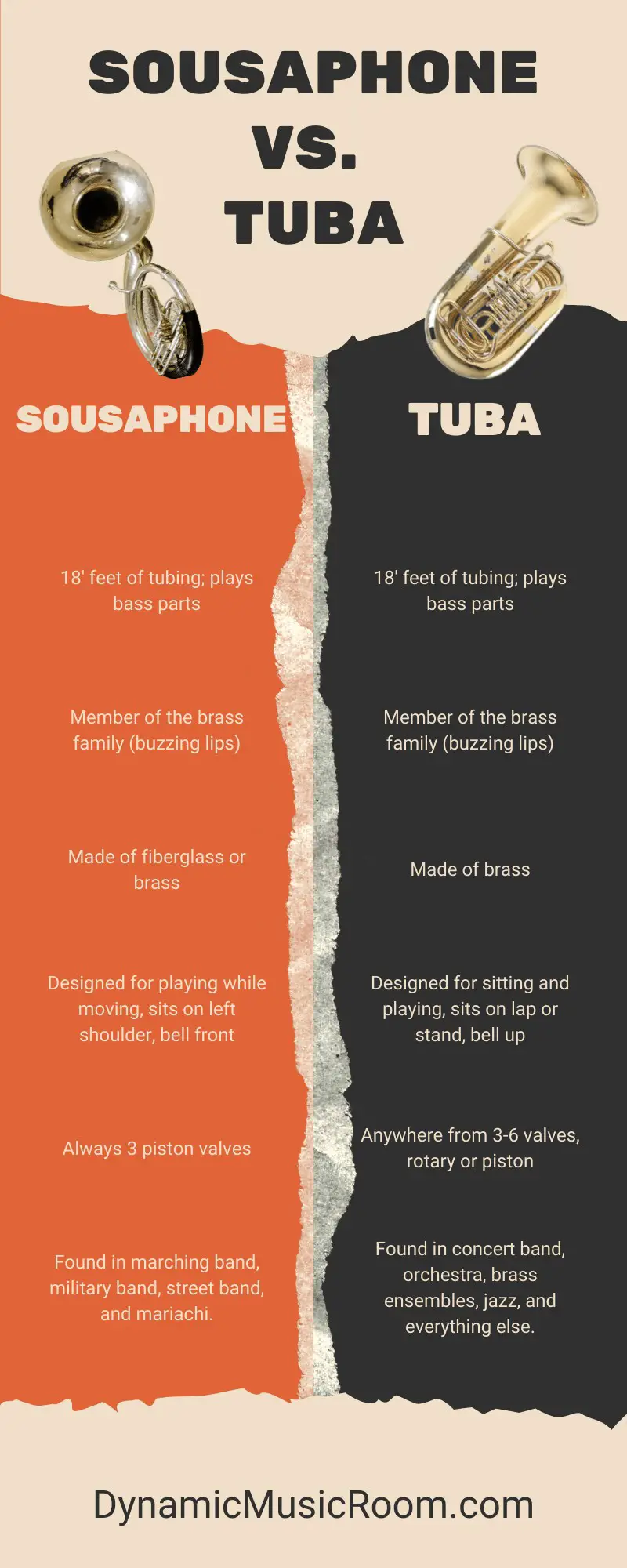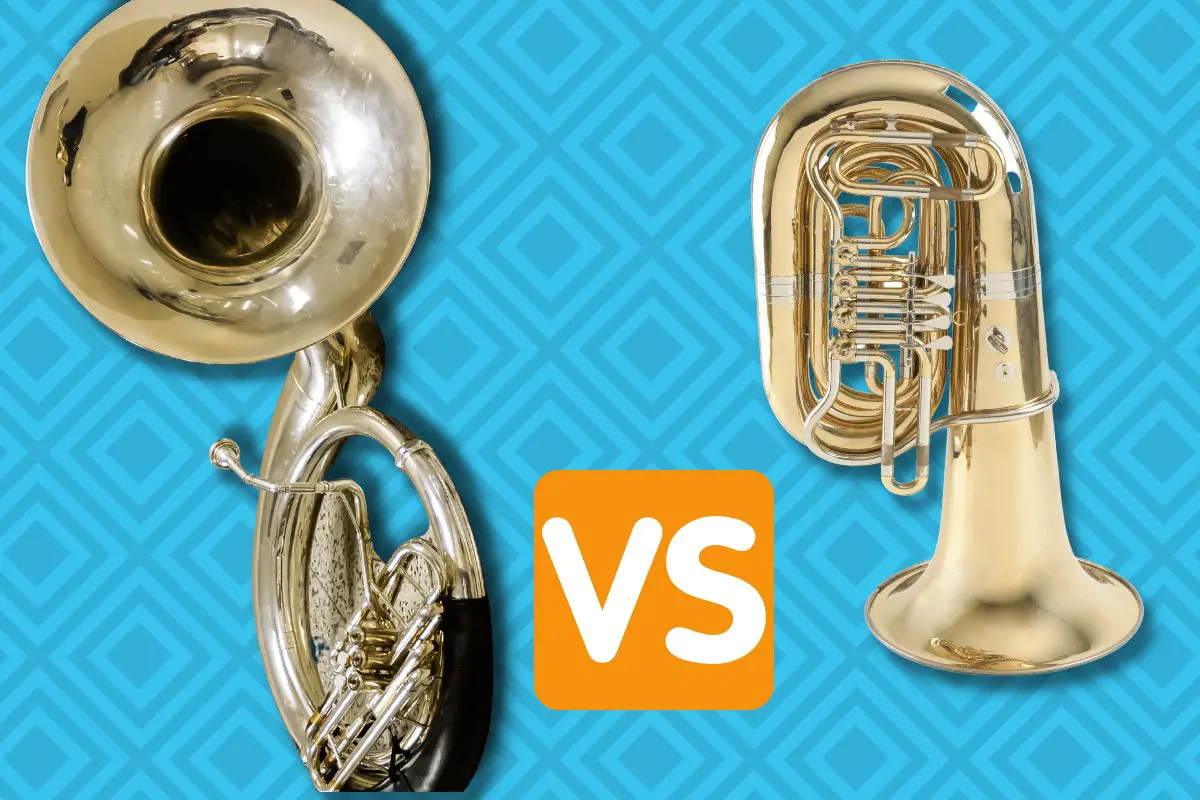The tub and the sousaphone are two of the most often-confused instruments in the band.
No, I don’t mean the players are confused (although, as a tuba player, I have to say this is also true).
I mean, how the two are confused about each other.
Many people call the tuba a tuba and the sousaphone a tuba.
While this isn’t strictly true, it’s not far off, though.
I wanted to settle the debate and set the record straight in this detailed Sousaphone vs. Tuba comparison, but here’s the short answer.
The main difference between a tuba and a sousaphone is the shape and shape. Both feature a similar length of tubing and play in the same range, but the sousaphone is designed to wrap around a player’s body and be carried. Many call the sousaphone a marching tuba.
Let’s dig in for more details!
Hey! If you like tuba stuff, check out my Instagram!
Table of Contents
Side By Side Comparison Of Sousaphone Vs. Tuba

What Is A Tuba?
A tuba is a brass instrument, meaning that it uses a mouthpiece, and the player buzzes their lips to produce a sound.
Tubas have somewhere between 3-6 valves, either rotary valves (paddle) or piston valves.
Its bell usually faces upward to remove the “tongue” sound you get when you have a large, forward-facing bell.
A standard BBb tuba has 18′ feet of tubing, making it the lowest brass instrument in the band and giving it the bass role.
Tubas and euphoniums look a lot alike because the euphonium/baritone was based on the tuba’s design.
Check out our article on Tuba Vs. Euphonium.
The tuba was invented in the 1830s by Germans Wilhelm Wieprecht and Johann Moritz, though other versions of the tuba were used before this (the Ophecleide being the most prominent).
Tubas are used in almost every group out there, including:
- Orchestra
- Brass ensembles
- Brass Quintet
- Concert Band (School Band)
- Brass Band
- German Band
- Jazz Band
- Wind Bands or Wind Ensembles
Most of the time, you’ll see only one tuba used, but there are usually more (if available) in large brass groups and concert bands.
What Is A Sousaphone?
A sousaphone is a similar instrument to the tuba, especially considering it was designed as a marching version of the horn.
The sousaphone has a similar length of tubing, though it usually stays around the 18′ foot mark.
The tubing wraps around the player’s body for easier carrying by bearing the weight on the player’s left shoulder.
The bell faces toward the front for a better direction of sound while outside.
It’s only commonly used in music where the player needs to move around, such as:
- Marching band/Military Bands
- Street bands
- Mariachi
Often, the bell may be detached for easier storage and adjustment to better fit how the player ends up carrying the sousaphone.
Sousaphone almost exclusively uses three piston valves, though four valves are sometimes available.
This is to further lighten up the horn by removing the need for extra tubing.
Modern sousaphones are either made of brass or lightweight fiberglass.
Fiberglass removes some of the dynamic power of the sousaphone, but it makes the musical instrument a lot lighter and easier to carry for the poor sousaphone players.
Sousaphones were invented by the American March King, John Philip Sousa because he felt bad for his tuba players carrying their horns during parades.
His most famous composition includes the Stars and Stripes Forever.
Truth be told, history attributes the making of the sousaphone (get it? “Sousa-” phone?) to John Philip Sousa, but the band director likely had little to do with the actual design.
While John Philip Sousa probably had some ideas in the general design, it was likely that the instrument maker, J. W. Pepper, was the one who actually did the inventing.
The original sousaphone was designed with bells facing up, which caused a problem when it rained.
For this reason, it was originally called a rain catcher at first.
Fun Fact: Most sousaphones in the marching band have a unique hat compared with the rest of the band.
It’s usually either a beret or a shorter hat like a Kangol.
This is because taller hats get caught on the bell as the sousaphones move around and do their cheers and commands.
Main Commonalities Between A Sousaphone And Tuba
Since the sousaphone was designed as a marching tuba, they have a lot of similarities.
We’ll run through them real quick in this section before getting to the key differences.
Both instruments are a member of the brass family of instruments.
They buzz their lips to produce their sound, like the other members, which include:
- Trumpet
- Cornet
- Flugelhorn
- French horn
- Trombone
- Euphonium
- Baritone
The two feature the same length of tubing for their fundamental note (often a Bb1).
They are also conical bore instruments, meaning they use a conical tube that grows from the lead pipe to the bell.
The sousaphone is branded as a marching tuba, and the scores for marching band music refer to this part as either Tuba or Basses (never sousaphones).
Both provide the bass sound to whatever band they’re playing in, as they have the lowest tonal range.
They are also the biggest instrument in the brass family.
Both use valves to change the length of their tubing and thus lower the pitch they’re playing.
Tubas and sousaphones are non-transposing instruments, meaning the notes they see on the page are what they actually sound like (called concert pitch).
They play in the exact same range of the notes as well, though the sousaphone has a more restricted range on the low end when compared to a tuba with four or more valves.
Main Differences Between A Tuba And Sousaphone
In this section, we’ll look at the major differences between a tuba and a sousaphone.
Remember, they are mostly the same, so every difference is really around the idea of making a tuba that’s easier to move and march with.
Design/Shape
Tubas are meant to be played while sitting.
The bell faces up, and all the tubing is wrapped up in front of the where the player would sit.
Sousaphones are more similar to the early helicon, which was a tuba wrapped around the player’s body.
The sousaphone, though, features an open wrapping where the weight of the horn sits on the player’s left shoulder.
This makes it easier to carry and play while moving.
The bells are also facing front, which serves the dual purpose of projecting sound directly (straight up sends the sound nowhere) and preventing rain from falling in.
Weird Fact: I’m such a band nerd; one of my senior pictures was me in a suit with my sousaphone from marching band.
Pitch (Sometimes)
Sousaphones are always BBb marching tubas.
This means that when they play their fundamental pitch (no valves pressed), it comes out as a Bb.
Many school tubas are also BBb tubas, so they use the same pitch.
But concert tubas (sit-down tubas may be easier to think of them as) come in varieties of pitches as you get better and better.
Among professionals, the most common type of tuba is actually a CC tuba.
For this horn, a C2 is the fundamental pitch.
Tubas also come in Eb and F varieties for more solo types of playing.
Speaking of solos, check out this list of famous tuba solos.
Valves
Both tuba and sousaphone use valves, sure, but there is more variety in the tuba valves.
Sousaphones are locked in with 3 piston valves.
Beginning tubas will also use 3 piston valves.
But as you get into nicer tubas, many of them will use 4 valves to help the instrument stay better in tune through all of its notes and play lower!
Some professional-level tubas even use 5 or 6 valves!
On top of this, tubas past the beginner level will use either rotary valves or piston valves.
Piston valves are the ones that go up and down and generally work faster and quieter.
But they also tend to get stuck more.
Rotary valves switch into place via springs and chambers and are pressed down with paddles.
They don’t move as fast, but they are consistent.
I have rotary valves on my CC tuba (5 of them!), and I almost never have to do anything to make sure they work.
Use
Sousaphones and tubas are used for completely different purposes and in different groups.
They almost never overlap.
Sousaphones run the world of marching bands, street bands, and mariachi.
Tubas get everything else.
Both are the bass part of whatever group they’re in, but you don’t cross them over often.
Material
For material, there is some variation between the two.
Tubas will always be made out of brass.
For sousaphones, it really depends.
Many high school groups will use fiberglass sousaphone with brass valves.
This makes the instrument lighter at the cost of sound.
Fiberglass will never sound as loud or have a rich tone as brass will.
It also lowers the price as fiberglass is much cheaper than brass too.
College and some high school marching bands will use brass sousaphones.
As someone who went from a fiberglass sousaphone in high school to a brass sousaphone in college, let me tell you:
The weight difference isn’t worth the sacrifice in tone quality.
If possible, opt for brass sousaphones.
Commonly Asked Questions
Are Tuba And Sousaphone Fingerings The Same?
As long as the tuba is a BBb tuba, then yes, the fingerings will be exactly the same from tuba to sousaphone. Tubas may have more valves, but sousaphones will always have three. More valves mean lower range and better in-tune playing, but sousaphones rarely play the music that needs a lot of altered notes anyway.
Can You Call A Sousaphone A Tuba?
It’s OK to call a sousaphone a tuba, but if you want to be more clear, it’s better to call it a marching tuba. Since they play the same and read the same music, more composers and arrangers simply mark the parts as Tuba or Basses to avoid confusion.
How Do You Wear A Sousaphone?
Sousaphones fit around your shoulders with the weight of the horn resting on your left shoulder. Little tubes called bits extend the mouthpiece and adjust the height to reach your mouth, so you don’t have to stretch your head forward. The bell should be facing straight ahead.

